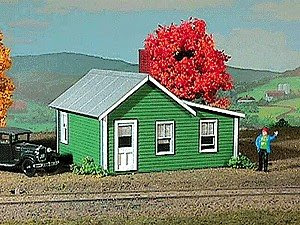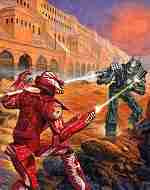
Chris Hanrahan of One Bad Egg tells of playing Dungeons & Dragons with a 5-year-old in the group, and making it work for everyone.
[Hat Tip 2 Sean Brady]

 I learned a new word!
I learned a new word!ambsace (AYM-zays) noun, also amesace[found on A.Word.A.Day *** Image ToyVault.com]1. The double ace, the lowest throw of the dice with one spot showing uppermost on both dice.
2. The smallest amount of anything.
3. Bad luck.
[From Middle English ambes as, from Old French, from Latin ambas (both) + as (aces).]
"O noble, prudent folk in happier case!
Your dice-box doth not tumble out ambsace ..."
Geoffrey Chaucer; The Man of Law's Tale; The Canterbury Tales; 1380.
 Ranking the relative skill and performance of people who play a game is an interesting problem. Physicist and Chess enthusiast Arpad Elo invented a system of ranking the relative skills that is both simple and flexible. Variation of the Elo rating system are used for Baseball, Basketball, Backgammon, Football (American rules and Soccer), Go, Pokemon, Scrabble, World of Warcraft, and many others.
Ranking the relative skill and performance of people who play a game is an interesting problem. Physicist and Chess enthusiast Arpad Elo invented a system of ranking the relative skills that is both simple and flexible. Variation of the Elo rating system are used for Baseball, Basketball, Backgammon, Football (American rules and Soccer), Go, Pokemon, Scrabble, World of Warcraft, and many others. If you have any interest in the NCAA Basketball Championship and March Madness, and have ever wondered how they come up with the team ratings, the Elo system is a big part of it. You can find Jeff Sagerin's Basketball (and other) rankings at USAtoday.com, and more rating from Jeff Sagarin at his site.
If you have any interest in the NCAA Basketball Championship and March Madness, and have ever wondered how they come up with the team ratings, the Elo system is a big part of it. You can find Jeff Sagerin's Basketball (and other) rankings at USAtoday.com, and more rating from Jeff Sagarin at his site. As much as I like miniature figures and painting, I think it's important to remember that my hobby owes a lot to other hobbies. This is why I try to support more than just the narrow aspects of Battletech miniatures the hobby I am interested in.
As much as I like miniature figures and painting, I think it's important to remember that my hobby owes a lot to other hobbies. This is why I try to support more than just the narrow aspects of Battletech miniatures the hobby I am interested in. Hiawatha Hobbies, the model train store closest to my home, is now open in it's new location at 2026 Silvernail Road, Waukesha, WI 53072. I visited today; the new store is nicely organized and much more visible than the old location, which ought to help them out. Train shops like this are a great resource for tools, paints, flocking, scenery, and tips on how to get tricky jobs done.
Hiawatha Hobbies, the model train store closest to my home, is now open in it's new location at 2026 Silvernail Road, Waukesha, WI 53072. I visited today; the new store is nicely organized and much more visible than the old location, which ought to help them out. Train shops like this are a great resource for tools, paints, flocking, scenery, and tips on how to get tricky jobs done. If you like working with miniatures as much as I do, then you can probably find something the train hobbyists use that will interest you too. Take time to find a visit a store like this. You might learn something new.
If you like working with miniatures as much as I do, then you can probably find something the train hobbyists use that will interest you too. Take time to find a visit a store like this. You might learn something new.







 1) Increase your Resources. The resource extraction level-up increases the production of all your resources. That means every hour, every day, 24/7, you get more resources to build your bases. None of the other choices give you back so much. The only down side is that the bonus you get is rounded down rather than carried over, so you need to invest a fair number of picks to get best use of this, but it is well worth it.
1) Increase your Resources. The resource extraction level-up increases the production of all your resources. That means every hour, every day, 24/7, you get more resources to build your bases. None of the other choices give you back so much. The only down side is that the bonus you get is rounded down rather than carried over, so you need to invest a fair number of picks to get best use of this, but it is well worth it. 3) Go back to #1 and #2. None of the other level-up choices are worth considering. Here is why Resouce Extraction (RE) is better than everything else: Protected Resources-->[useless] You save a tiny amount when you get raided, but you could more than make up for the loss with RE, and eventually you can build Bunkers to do this job better. Max Resource Storage-->[useless] Same reasoning, for the little bit extra you can save you could be building other building with have the same effect. More Energy-->[barely useful] With RE you can build more tiles and more reactors instead. Sensor Power-->With RE you can build more tiles and more
3) Go back to #1 and #2. None of the other level-up choices are worth considering. Here is why Resouce Extraction (RE) is better than everything else: Protected Resources-->[useless] You save a tiny amount when you get raided, but you could more than make up for the loss with RE, and eventually you can build Bunkers to do this job better. Max Resource Storage-->[useless] Same reasoning, for the little bit extra you can save you could be building other building with have the same effect. More Energy-->[barely useful] With RE you can build more tiles and more reactors instead. Sensor Power-->With RE you can build more tiles and more  Combat:
Combat: 2) In proportion. The only random part of combat is how damage is allocated amount difference groups of units. It appears that units in your force are randomly selected to be destroyed, and combat ends when the total resistance of the units absorbs all of the attack strength. The allocation of damage is proportional to the types of units is your force, but different units have different resistance. This means that by including some Boga (no offense, high resistance) in with a group of Veen (light combat mecha), the Boga will absorb proportionally more damage, letting more of the Veen survive. This might not be the most efficient way to attack, but it can help a smaller group of Veen make a successful attack against a well defended target.
2) In proportion. The only random part of combat is how damage is allocated amount difference groups of units. It appears that units in your force are randomly selected to be destroyed, and combat ends when the total resistance of the units absorbs all of the attack strength. The allocation of damage is proportional to the types of units is your force, but different units have different resistance. This means that by including some Boga (no offense, high resistance) in with a group of Veen (light combat mecha), the Boga will absorb proportionally more damage, letting more of the Veen survive. This might not be the most efficient way to attack, but it can help a smaller group of Veen make a successful attack against a well defended target. I tried an experiment with our local Battletech group last night. I recall seeing Chess demonstrations were one player (generally a very good player) would play 10+ games at once, walking around a circle of players each with there own board, and I've been wanting to try this with Battletech. In recent weeks we have been playing a series of tournament style games where two players pair off with two Battlemechs each. Tonight I set up 4 identical battles and played against 4 others, all at once.
I tried an experiment with our local Battletech group last night. I recall seeing Chess demonstrations were one player (generally a very good player) would play 10+ games at once, walking around a circle of players each with there own board, and I've been wanting to try this with Battletech. In recent weeks we have been playing a series of tournament style games where two players pair off with two Battlemechs each. Tonight I set up 4 identical battles and played against 4 others, all at once. The Setup:
The Setup: The Plan:
The Plan: Initiative:
Initiative: Fire Phase:
Fire Phase: Results:
Results: Recap:
Recap: In summary, it was an interesting and fun experiment,and I would do it again sometime. With a bit more refinement this might make an interesting convention event, where many players could match themselves against a panel of expert level players (one per round) in a sort of mini-tournament.
In summary, it was an interesting and fun experiment,and I would do it again sometime. With a bit more refinement this might make an interesting convention event, where many players could match themselves against a panel of expert level players (one per round) in a sort of mini-tournament.
 Since symmetry underlies a lots of common games and puzzles, I expect there are some useful connections to look into and write about. I might have to do some serious homework first though. Learning something new about math (or anything else) is a bit like figuring out a puzzle; First you work hard at it, then you enjoy the payoff when you figure it out.
Since symmetry underlies a lots of common games and puzzles, I expect there are some useful connections to look into and write about. I might have to do some serious homework first though. Learning something new about math (or anything else) is a bit like figuring out a puzzle; First you work hard at it, then you enjoy the payoff when you figure it out.
 1) Concrete is Precious. Concrete is the most important resource in the game, and if you have enough concrete (and a bit of money) it will enable you to do anything else you want to do. Protect it, use it wisely, but most importantly use it before someone steals it from you.
1) Concrete is Precious. Concrete is the most important resource in the game, and if you have enough concrete (and a bit of money) it will enable you to do anything else you want to do. Protect it, use it wisely, but most importantly use it before someone steals it from you. 2) Expand. Multiple bases are key to increasing you resource production. Build new bases as soon as you can, and put 2 or 3 concrete plants on each. You are automatically allowed a new base as you gain certain levels (3,6?,?), and you you should save some level-up choices to have enough (you need 5 each)for extra bases as you gain levels too.
2) Expand. Multiple bases are key to increasing you resource production. Build new bases as soon as you can, and put 2 or 3 concrete plants on each. You are automatically allowed a new base as you gain certain levels (3,6?,?), and you you should save some level-up choices to have enough (you need 5 each)for extra bases as you gain levels too. 3) Float Resources. Use Bogas (cargo mecha) for short-term storage of resources so that you base won't stop producing as it reaches the maximum limit. These Bogas are vulnerable to your human neighbors attacking them, but if you keep them in groups of 1 or 2, and keep them out of detection range of enemy bases. You can also send 'slow' transport/transfer mission between bases. One or two Bogas are generally undetectable, and the resources they carry are safe while in-transit. This is especially helpful for overnight (or work-day) missions; time the arrivals so the resources are there when you will next log in.
3) Float Resources. Use Bogas (cargo mecha) for short-term storage of resources so that you base won't stop producing as it reaches the maximum limit. These Bogas are vulnerable to your human neighbors attacking them, but if you keep them in groups of 1 or 2, and keep them out of detection range of enemy bases. You can also send 'slow' transport/transfer mission between bases. One or two Bogas are generally undetectable, and the resources they carry are safe while in-transit. This is especially helpful for overnight (or work-day) missions; time the arrivals so the resources are there when you will next log in. 4) Transfer not transport. If you haven't noticed already, your Bogas cannot transport resources to a base once that base has reached its maximum storage (the resources just stay in the Boga for the return trip). However, you can transfer Bogas full of resources and exceed this limit. This is one thing I wish could be changed, because all it does is create busy work, forcing me to use two transfer missions in place of a single transport mission.
4) Transfer not transport. If you haven't noticed already, your Bogas cannot transport resources to a base once that base has reached its maximum storage (the resources just stay in the Boga for the return trip). However, you can transfer Bogas full of resources and exceed this limit. This is one thing I wish could be changed, because all it does is create busy work, forcing me to use two transfer missions in place of a single transport mission. 1) Be flexible. Sometimes you will want extra hangar space, other times you might need to maximize your cash production. Don't be afraid to tear down building you don't need at the moment and put up those you do. Advance Hangars and Gen Mines are conveniently the same size, and make an easy swap.
1) Be flexible. Sometimes you will want extra hangar space, other times you might need to maximize your cash production. Don't be afraid to tear down building you don't need at the moment and put up those you do. Advance Hangars and Gen Mines are conveniently the same size, and make an easy swap. 1) Turn it off. If you aren't doing research currently, power down your research facility and use the power for something else, like powering Turrets and Rocket Towers.
1) Turn it off. If you aren't doing research currently, power down your research facility and use the power for something else, like powering Turrets and Rocket Towers.